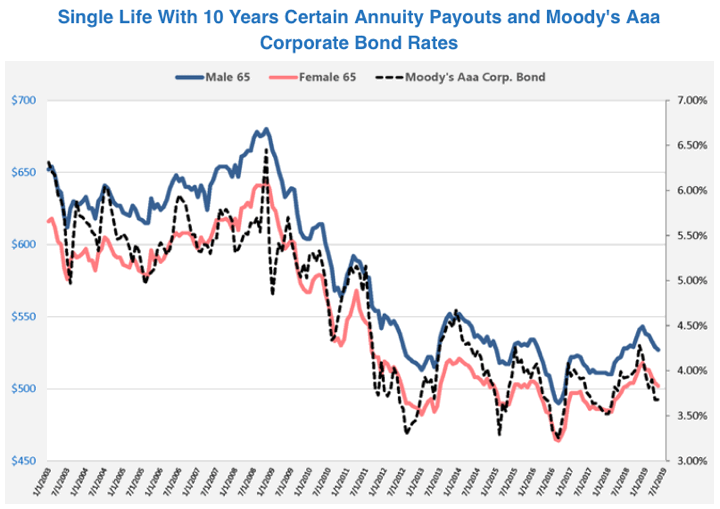
I’m still learning about immediate annuities as a potential future income stream, and came across this ImmediateAnnuities.com article about the relationship between immediate annuity payout rates and interest rates. (Note: I am not talking about indexed or variable annuities. Those I avoid completely.) The chart below shows the close relationship between the payout rate for a common type of immediate annuity (single life, 10-year guaranteed payout) and the interest rate on high-quality long-term corporate bonds.

At the same time, there is much less correlation between the payout rates and short-term interest rates. The “Fed Funds Rate” that you hear about all the time in the financial media is a short-term rate set by the Federal Reserve.
Even though annuities like to tout themselves as “guaranteed”, nominal annuities with a fixed payout are still exposed to inflation risk. For example, your contract might state a fixed payout of $1,000 a month for the rest of your life, but if inflation spikes, that $1,000 won’t go nearly as far. With 3% average inflation, your effective paycheck shrinks to only $640 of equivalent buying power after 15 years. With 4% inflation, it shrinks to $550 of buying power.
Right now, long-term interest rates are near historical low and thus so are payouts. You could argue that your downside potential is much greater than the upside as historically there are many more examples of extended periods of high inflation than extended periods of deflation. I don’t want to buy a 20-year bond paying the current market rate of 3.5%, but I really don’t want to locked in what is essentially a lifetime bond paying 4%.
Now, if you are definitely going to buy an annuity, the article does make a valid point that if you wait a year for rates to increase, that’s one less year of income you earn from a lifetime annuity. You may also opt to hedge your inflation risk elsewhere.
I’m still decades away from the age when I would like to buy an annuity, but I do think now is a very tough time for current retirees trying to create guaranteed income. The income available from “safe” investments are so low, and you do even worse after taxes. However, I simply don’t buy into the theory that inflation has gone away forever, and I personally would have a hard time buying an annuity at current rates.
 The Best Credit Card Bonus Offers – 2025
The Best Credit Card Bonus Offers – 2025 Big List of Free Stocks from Brokerage Apps
Big List of Free Stocks from Brokerage Apps Best Interest Rates on Cash - 2025
Best Interest Rates on Cash - 2025 Free Credit Scores x 3 + Free Credit Monitoring
Free Credit Scores x 3 + Free Credit Monitoring Best No Fee 0% APR Balance Transfer Offers
Best No Fee 0% APR Balance Transfer Offers Little-Known Cellular Data Plans That Can Save Big Money
Little-Known Cellular Data Plans That Can Save Big Money How To Haggle Your Cable or Direct TV Bill
How To Haggle Your Cable or Direct TV Bill Big List of Free Consumer Data Reports (Credit, Rent, Work)
Big List of Free Consumer Data Reports (Credit, Rent, Work)
If I were to say “I simply don‘t buy into the theory that…” followed by an exaggeration or catastrophization, I’d like to have a good friend around to challenge me.
So I’ll be your good friend today, Jonathan. Reconsider the merits of a regular buying program in EE bonds.
I mention the pros and cons of EE bonds on each of my monthly interest rate updates. They can be a helpful tool in some portfolios, and certainly look better whenever rates drop. With EE Bonds, I don’t like that I am not allowed to change my mind any time in the next 20 years without a big penalty. Other folks may not mind as long as they get 3.5% for 20 years instead of the current market rate.
https://www.mymoneyblog.com/best-interest-rates-cash-june-2019.html
I would say this has less to with risk preference and more to do with objective optimality. Especially given the low/negative interest rate environment that has been part of the global—if not always domestic—landscape for many years now, I do think you’re a bit dogmatic in your rejection of protracted deflation/disinflation as a portfolio concern, and dogma is always a flashing red light. Liquidity, like risk, is a portfolio-level issue rather than a security-level issue. But we’ll agree to disagree.
I acknowledge deflation as a portfolio concern, but I think it is adequately protected against for my tastes by a long-term holding of stocks, a high-quality intermediate-term bond ladder (via mutual fund), and a big cash cushion.
You briefly mention in brackets that, “Note: (You) I am not talking about indexed (the assumption is fixed index) or variable annuities.) Thank you for the disclaimer. There are consumers who are unfamiliar with the fact that those two types of annuities have a guaranteed lifetime payout feature, which is not linked to the interest rates at issue, fortunately. Quite the opposite of immediate and deferred annuities, with a fixed index annuity for example, the consumer maintains access to the principal which is protected, owns and retains all the gains (most companies now offer uncapped blended indexes), and can and will benefit from the lifetime income feature known as a GLWB, (Guaranteed Lifetime Withdrawal Benefit). If the health or financial situation changes the consumer can get the money back or accelerate the payment terms (shorten the payout to ten years rather than lifetime).
Once the original term on the contract,typically 5,7,or 10 years is matured, the GLWB continues without renewing. At that point, the asset is 100% available for withdrawal without a penalty. Prior to maturity, typically 10% is available each year without a penalty. Lump sum withdrawals do, however, make a recalculation of the income amount necessary. The fee ranges among annuity companies between 0%-1.10% for the GLWB, and insures that if the consumer outlives the principal and the gains, the cash flow continues, unchanged and uninterrupted.
I’d like to believe that there are variable / indexed annuities that are actually OK investments and not full of inflated fees and commission sales charges buried in them. Sadly I’ve yet to see one.
Can you point to a contract for such annuity with all the fees and terms documented ?
Documentation of fees and terms are found in the product literature specific to policies discussed offered from the insurance companies.Products such as variable annuities are the source of the vast majority of the negative connotation consumers have about the word annuity. High fees, no principal protection, no retention of gains, and a lesser withdrawal percentage are associated with variable annuities. However the fixed index type typically has no fee for the base product and the (GLWB) Guaranteed Lifetime Withdrawal Benefit has a fee of between 0% -1.10% each year, with no front load, the actual fee is specific to the policy. The better policies credit at least 100% of the index gains, and some above 100% of the index gains. However, among the available fixed index policies, there are still a few remaining index allocation choices which credit less than 100%. This feature is referred to as a participation rate. With those allocation choices, the insurance company shares part of the gain with the consumer, as the index gains are reduced prior to being credited to the consumer’s policy based upon the participation rate. That ‘sharing’ of index gains can be viewed as a fee; however, it is not assessed on the principal balance. All insurance companies disclose the fees for the GLWB in the brochures specific to each policy offered and additionally on the illustrations provided based upon the parameters described by the consumer. Fortunately,the fees are spelled out in advance so there are no surprises. Lastly,provided the individual presenting to the consumer has completed product training, all options and fees are disclosed to accurately educate the consumer prior to submitting an application.
“found in the product literature specific to policies ”
Can you point us to a good one that you’ve bought or know of as an example ?
There is so much information about annuities out there and most of it is negative. You could easily construct a 25/75 fund which would do the same thing but keep up with inflation and remain liquid. I know you like iBonds so put your projected balance in a withdrawal calculator. I think you will like your guaranteed, inflation protected annuity stream.
I would like to see a comparison of the results of $100,000 spent on (1) a “real” inflation-indexed immediate annuity and (2) the same amount of money split between a nominal immediate annuity and TIPS.
Your credibility is taking a hit with this talk of annuities.
Hmm… that seems like a rather vague criticism? Why not just tell me where I’m wrong or how you disagree? I can’t tell if you are a pro-annuity person that thinks I am anti-annuity, or if you are an anti-annuity person who thinks I am pro-annuity. I’ve gotten angry comments from both sides. I’m definitely not an expert on annuities, and I am trying to figure it out myself as someone that is seriously considering whether to buy an SPIA eventually. That why I share charts like this one.
Annuities have a bad reputation and I think rightly so. But there are a lot of different kinds of annuities.
I see nothing wrong with fixed immediate annuities. They are as simple and straight forward as a standard loan contract.